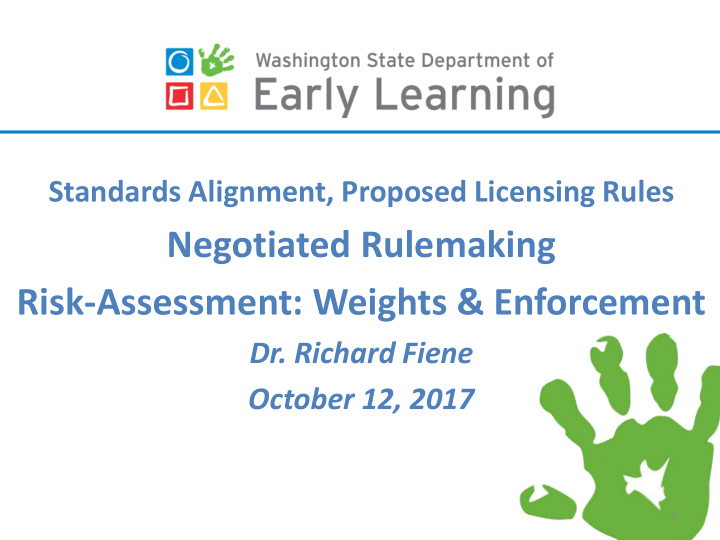



Standards Alignment, Proposed Licensing Rules Negotiated Rulemaking Risk-Assessment: Weights & Enforcement Dr. Richard Fiene October 12, 2017 1
We are committed to creating and maintaining high quality early learning environments that protect and nurture children and prepare them for kindergarten. 2
Introduction Richard Fiene, PhD. Psychology and human development at Penn State University. Working to improve the overall quality of care for young children: Key indicators Risk assessment Differential monitoring 3
Why Weights? Risk assessment = Theory of Regulatory Compliance – All rules were not created equal nor administered equally. – Many rules were administered in a very differential manner. Licensing risk assessment or weighting of rules Stepping Stones to Caring for Our Children . By using the risk assessment methodology, it naturally leads us to more focused or differential monitoring where a subset of rules based upon their risk assessment are measured rather than the full set of rules. 4
Risk Assessment Matrix (RAM) Likelihood that a particular rule will be out of compliance or when reviewed shows systemic problems. Determine the percentage or frequency of this rule being of concern. 5
Validation Process The first approach in validating the risk assessment rules is to compare the state’s rules to Stepping Stones to Caring for Our Children which is the default set of national rules developed via the risk assessment methodology. Standards Approach . The second approach in validating the risk assessment rules is to correlate the risk assessment scores along with full compliance scores to make certain that the risk assessment rules non- compliance is occurring in the more highly non-compliant programs. Measures Approach . 6
Validation Process The third approach in validating the risk assessment rules is to match the decisions being made regarding the level of licensing and the risk assessment scores. Again there should be a high correlation between the two. Output Approach. The fourth and final approach in validating is to compare the risk assessment rules to outcome data such as the health and safety of children through injury reports, etc. Outcome Approach. 7
Final Thoughts The four approaches are taken from Zellman and Fiene’s (2012) research brief on • Validating QRIS which has direct applicability to licensing systems as well. Approaches 1 and 2 are relatively short time frames because the necessary data to • be compared are readily available. If Approach 3 is done retrospectively it can be accomplished relatively quickly but if new data are needed, then a minimum of 6 months will be needed. The last Approach 4 usually takes the longest because the data are not usually collected systematically. This step can easily take a year to complete. I would also recommend that you look at the Office of Child Care and Assistant • Secretary's Office for Planning and Evaluation Briefs on Licensing and Monitoring systems which will provide additional guidance on the latest research into this methodology and how it ties into differential monitoring in general. 8
Recommend
More recommend